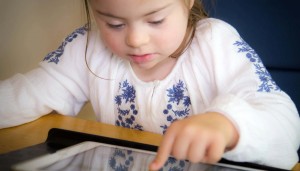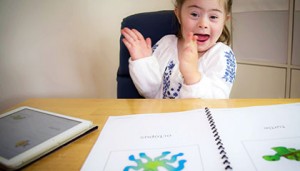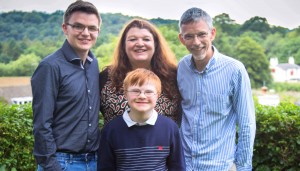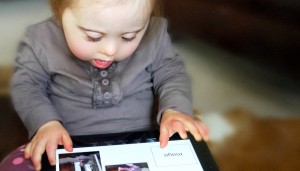
Tablets and smartphones are a way of life for children in the second decade of the 21st Century – but how much screen time is healthy? As the debate continues about giving young people unfettered access to connected gadgets, it seems that for one cohort the benefits are inarguably positive…
Connected devices like smartphones and tablets are part and parcel of modern life. The number of smartphones, in particular, has reached saturation point. Four out of five adults in the UK has a smartphone – the equivalent of 37 million people – with many having two or more such devices.
According to a survey from Deloitte conducted last year some heavy users exhibit the characteristics of addiction, fretting when they are parted from their devices and waking in the night to check their screens for messages.
So what about children? Are adults wrong to use tablets as pacifiers or should we encourage children to learn the basics as soon as they are able? Maybe the debate has already been lost. Walk down any high street and you’ll see scores of teenagers, smartphone in hand, tapping out messages with their thumbs oblivious to the real world going on around them.
Children have embraced new technology, leaving adults – juggling jobs and parental responsibilities with their leisure time – scrambling to keep up.
Despite the naysayers, research has shown that when they are used correctly, tablets and smartphones can have a beneficial effect. Educational apps can be useful in teaching young children to read and improve their vocabulary. Touch apps help hand-eye co-ordination and creativity. Mobile learning apps are free from space constraints – a child can learn during five minutes of downtime or during long train journeys or flights.
Educational apps can be particularly beneficial for youngsters with special needs. Children with motor skills challenges find the intuitive touch screen interface much easier to use. Steve Jobs – the genius behind the iPhone and iPad – once famously scorned the notion of using a stylus on a touch screen. “Who wants a stylus?” Jobs asked. “You have to get them and put them away and you lose them. Yuck! Nobody wants a stylus.” Instead, the iPhone and the iPad would use “the best pointing device in the world”, said Jobs. The human finger. As far as children with motor skills challenges are concerned, Jobs’ was absolutely right. Picking up a stylus – or a pen – is a chore. Pointing at something with a finger feels natural.

There are more than 60,000 educational apps in the Apple App store – but how many are fit for purpose, especially if you have a child with a disability?
Colin and Beverley Dean launched Special iApps as a non-profit social enterprise from their home in Durham City six years ago. The couple, who both have a background in computer programming, decided to make their own apps after a frustrating quest to find suitable software for their youngest son, William, who has Down syndrome and physical problems, including duodenal atresia, Hirschsprung’s disease, hearing impairment and thyroid deficiency, which affect his speech and learning abilities.
Beverley explains: “A friend urged us to buy an iPad for William. We were in the Apple Store in Newcastle just looking at the phones and a mum who was with her disabled son said: “Oh you must get one of these for William”. She took her iPhone out of her pocket and gave it to her son. He flicked through lots of different apps and her son was transformed. He went from being totally bored and fed-up to engaging with her and trying to vocalise because she kept switching the apps and he wanted something else.”
The couple were sold on the technology and bought an iPhone immediately but their excitement was short lived. “I got it home and downloaded some apps,” continues Beverley. “But after a while I realised that William wouldn’t be able to use them. They were too fast or you had to go through a learning journey and, for him, that was an exercise in frustration. He didn’t want to do the bit at the beginning, or the middle, he just wanted to do the bit at the end. But those activities wouldn’t be unlocked unless he’d done the others first – or there would be a distracting character on the screen that would attract his attention. There were loads of distractions.
“Or if I could find a simple one I’d answer a question and the screen would go blank as it moved on to the next activity. I couldn’t sit down with William and say: ‘Look that’s what you’ve done”. William’s memory needed longer to process the outcome.”
Colin explains: “A lot of apps include distracting sounds and animations. This is a bit like TV news bulletins, where there is a person talking, people walking around in the studio behind, a graphic in a rectangular window at the top right with some video playing and a ticker-tape scrolling across the screen at the bottom. There’s all this stuff going on at once and it’s far too much for someone with a learning disability. If you have autism or Down syndrome these apps give you sensory overload.
“It might keep kids occupied and entertained but it doesn’t actually teach them anything and, for some, it’s totally overwhelming and they don’t know what they are supposed to be doing.”
So Beverley asked Colin, who was working in the IT department at Durham University, if he could create an app specifically aimed at children with special educational needs and disabilities with her guidance. “I said to Colin “look this doesn’t work – I’m sure we could do something better than this”. We’re both programmers and we code together. Colin asked what I wanted and I started pulling out all the resources I had in the cupboard.”

For his part, Colin went out and bought himself a book: Teach Yourself iPhone Programming in 24 Hours. In the event it took more like 24 days but it wasn’t long before he had something running as a simulator for William to play around with. Colin explains: “My background is in programming so it wasn’t as if I was starting from scratch. However, it was very different for me because I tended to work at lower levels, systems – IT services – I hadn’t really got much experience in user interface and design. I approached it from the point of view of the resources Beverley had on paper that I knew she wanted to use electronically.”
They started with an iPod touch, a £3,000 grant from UnLtd, a social enterprise charity, and an interest-free credit card which enabled them to buy a Mac and join the Apple Developers Programme. Between them they came up with Special Words, an app which encourages children to match colourful pictures to words.
Although Special Words looks elementary, the visual simplicity masks a complex application which has been designed from scratch to encourage hand-eye co-ordination, increase a child’s vocabulary and improve their vocalisation.
Beverley says: “The key was to make it simple to look at – even when there’s loads going on under the hood. You can send data to another device, print it out and Bluetooth it from Android devices to Apple, because we have customers who might have an iPad and an Android phone, but to a child it’s just a fun activity.”
The first app was a real family affair. Beverley provided the ideas and the resources needed, Colin coded the software, Joseph, the couple’s eldest son, added his voice to the app and, of course, William and his friends acted as beta testers.
Colin says the children’s input was crucial: “We could observe them using the apps. If you have poor hand-eye co-ordination and I give you some physical cards to pick up it is quite difficult. The cards are thin, you can’t get your fingers underneath easily etc. On the other hand, if you put something in front of them to touch and move around it’s much easier than in the real world.
“That helped us realised that there were things William was doing that didn’t work. For instance, he was dragging one of the cards off the screen or he would let go while moving something. That’s where we found the existing apps were unusable because there would be an invisible elastic band dragging the card back or you’d have to place things very precisely.
“If you ask an adult to place a card on a square they place the card within 2mm before letting go. Children with special educational needs don’t conform to that. Therefore, our apps have no negative reward if you don’t conform to the normal expectation.”
Beverley’s circle of mums and dads also helped: “We received great feedback from parents. We had a friend whose husband was American and their little girl was playing with Special Words on our iPod touch. She lay on the floor and played with it while we talked for about half an hour. Afterwards, her mum said: “I can’t believe that because when the speech therapist asks her to do something she has a temper tantrum.” Yet here she was using something very small like an iPod touch because the app engaged her.”

When it went on sale in 2011, Special Words was an instant hit. William’s app was a boon to other children just like him all over the world.
And it wasn’t just parents but also teachers who were encouraging children to use Special Words to enhance their skills.
The first customer was Hilary Stock, a computer specialist from the Champion Centre in Christchurch, New Zealand, a centre for children with mixed disabilities. She still uses it every day.
Hilary, who specialises in the development and delivery of computer and iPad programmes for children with special needs, says: “I like the overall, simplicity of the app. It is engaging and reinforcing without having a whole lot of ‘cute’ animations which could act as distractions.”
Six years later, the company has a family of Special iApps including Special Stories, which helps children create a narrative on a tablet device, Special Numbers, which teaches basic numeracy, Match & Find, My First Signs and Touch Apps for early years.
Along the way they have been joined by another mum, designer and photographer Barbara Lowe, whose daughter Maya also has Down syndrome, and finance specialist Sian Thomas.
“We have put a huge amount of work and research into the design of the images,” said Barbara. “For example, we found that children who have autism find aligned images appealing and those who have Down syndrome find it difficult to see pastel colours. So our images are bright, cheerful and free from unnecessary clutter.”
The couple say they came to a crossroads – they could have given up and just concentrated on looking after William or pressed ahead with their ideas in a bid to make Special iApps an international success story.
“To date we’ve got by keeping our costs very, very low and having some savings and shares from a previous existence,” admits Colin. “We asked ourselves: Have we got a viable business? Or do we keep this as a hobby, retire and look after William, but there are so many more kids we could help.”
So now the couple are preparing to launch a major revision of their first app and gearing up for a major marketing blitz.
Beverley said: “We have developed a new version of the app, Special Words Pro, which can print out your stuff, produces blank reports and has a huge number of curriculum-related resources which can be downloaded.
“We have created resources covering the school curriculum from early years upwards with subjects ranging from the weather, Egyptians, lifecycles and the four seasons. These add-ons are available to download from our website.”
To go along with that the couple have engaged the services of a marketing agency – Darlington-based Real Results Marketing – and are looking to the launch of the new pro version of Special Words later this month as a relaunch of the entire company.
“We firmly believe there is a market for Special iApps and we don’t want to stop,” adds Beverley. “There’s so much more we could do, especially when we look at how many apps we sell due largely to word of mouth.”
And then there is the company’s chief tester, William, who has just transitioned to secondary school this Autumn.
“We see Special iApps as William’s legacy to the millions of other children all over the world with special needs,” said Colin.
“Without him we wouldn’t have done it and thousands of children around the world wouldn’t be using it.”
For more information go to our Special i apps website
Please submit your comments below.
Do you have something to say about this or any other school management issue which you'd like to share? Then write for us!






